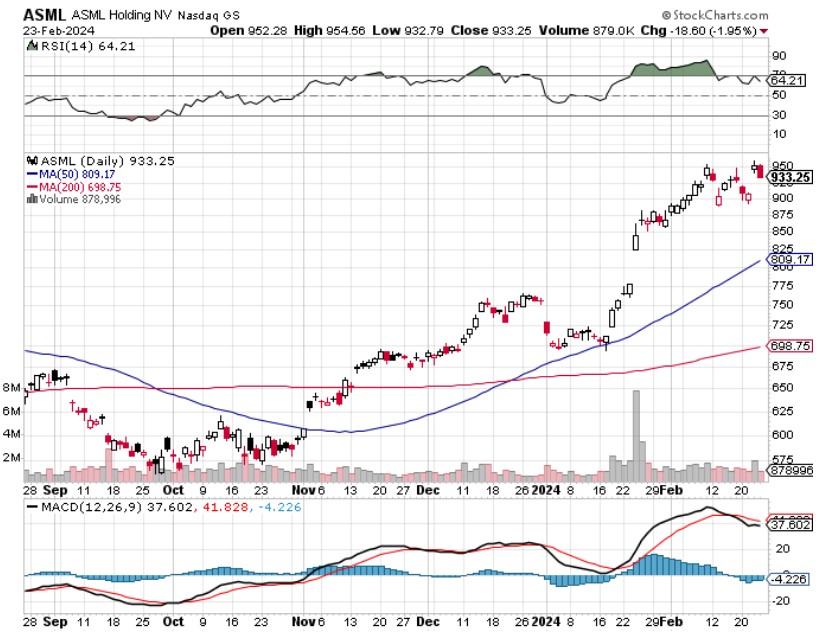(ASML), (NVDA), (AMD), (SMCI), (TSM)
Investing in AI feels a bit like trying to sip from a firehose – overwhelming, to say the least. The landscape is teeming with contenders, from savvy businesses harnessing AI to sharpen their edge, to the wizards creating the software that's the lifeblood of AI.
But let’s not forget the unsung heroes: the hardware components. These are the bread and butter of AI, and companies like NVIDIA (NVDA), Advanced Micro Devices (AMD), Super Micro Computer (SMCI), and Taiwan Semiconductor (TSM) are the rock stars on this stage.
Yet, there's a titan in the shadows, poised for a spotlight moment: ASML Holding (ASML).
Imagine every AI model as a gourmet dish, and at the heart of each, there’s a microchip – the secret sauce. Crafting these chips requires machinery so advanced it might as well be from the future, and ASML is the master behind it.
Known as EUV (extreme ultraviolet), ASML holds the technology behind powerful lithography machines that sketch the delicate, conductive traces on chips.
We're talking about a finesse so fine that these traces are now as narrow as 3 nanometers. To put that into perspective, a strand of human hair is a hulking 80,000 nanometers in comparison.
Here's why it's a big deal.
First off, let's get to grips with what EUV is all about. Imagine trying to paint the Mona Lisa on a grain of rice. Sounds impossible, right? That's what microchip manufacturers were up against, trying to fit more and more transistors onto a chip to power the brain of AI systems.
Enter EUV technology. It's like swapping out a bulky paintbrush for a laser-precise pen, allowing for incredibly detailed patterns on microchips.
This means more power, speed, and efficiency for AI technologies, from autonomous cars to smart appliances.
In essence, EUV is making the impossible possible, allowing chips to get smaller, faster, and smarter.
Now, why should you care? Because EUV technology is the golden ticket in the semiconductor industry. It's what's going to fuel the next wave of AI advancements.
As AI technologies become more integrated into our lives, the demand for these super-powered chips is going to skyrocket.
So, where does ASML fit into this picture?
Well, ASML is the only show in town when it comes to EUV lithography systems. They've got a monopoly on this game-changing tech.
As AI continues to grow, so does the need for what ASML provides. It's like owning the only factory that makes the secret sauce everyone needs. And with the semiconductor industry being as competitive as it is, having that kind of edge is invaluable.
Their status as a lone wolf in this arena justifies their revenue guidance of $32.4 billion to $43.2 billion by 2025, coupled with a gross margin that's as impressive as their tech.
Thanks to the advent of AI, the semiconductor industry is on the brink of a gold rush, with analysts forecasting a boom of 42 new fabrication plants in 2024 alone.
This is a significant leap from the past, signaling a rebound in spending on the very semiconductor manufacturing equipment that ASML specializes in.
After a slight dip in 2023, spending is expected to skyrocket to $124 billion by 2025.
ASML, riding this wave, has already seen its order books bulge with bookings worth $9.936 billion in just the last quarter of 2023.
This puts ASML in an enviable position, with a backlog that's more robust than its revenue forecast for the year.
The company, which reported revenues of $29.81 billion in 2023, is eyeing a repeat performance in 2024, with sights set on even greater growth fueled by this semiconductor spree.
What's the bottom line for ASML? This company is projected to report a significant earnings leap from 2025, driven by improved market conditions and a backlog that's the envy of the industry.
With predictions pointing towards earnings of $36 per share in 2026 and a potential stock price surge to $1,260, ASML represents a golden opportunity for investors looking to tap into the semiconductor industry's growth without paying the premium prices commanded by others like Nvidia. I suggest you buy the dip.



